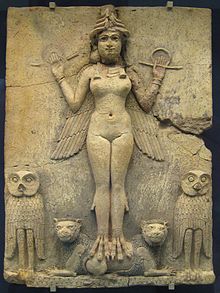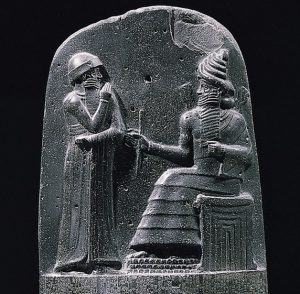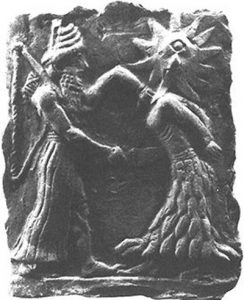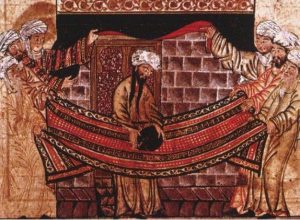 New evidence and interpretation at the intersection of planetary science and religion can help us better understand the history of the Ancient Near East and of the origins of Islam.
New evidence and interpretation at the intersection of planetary science and religion can help us better understand the history of the Ancient Near East and of the origins of Islam.
A Revised Venus Theory corrects Immanuel Velikovsky’s original theory that the planet Venus first entered the inner solar system as a comet with a bifurcated tail around 1500 BC (new evidence indicates around 2525 BC). Now we have a much better explanation of the origin of Venus (rather than fissioning off of Jupiter, it was pulled from the outer solar system by Jupiter’s gravity and, via tidal heating, became a comet with a long tail). Venus interacted with the Earth on a 52-year cycle during the Late Bronze Age, causing catastrophes worldwide. And we now have a framework theory of the terrestrial planets into which these phenomena neatly fit and for which there is telling evidence. For Comet Venus, there is also newly interpreted, compelling iconographic and linguistic evidence. The names of both Athena (A Fena, the Phoenician) and Poseidon (Bos eidon, the Bull of Heaven), for instance, referred to the double-tailed Venus.
So with new-found confidence that the Ancients and Velikovsky were right about Venus, we can ask how can we use this to decipher aspects of the culture of the Ancient Near East and of the background of Islam.
Ishtar, Astarte, Ashur
To start with, we can see a simple explanation of the names Ishtar and Astarte, the great Venus goddesses of the ancient Semites who suddenly appeared around 2500 BC (the Sumerian goddess Inanna was coopted for Venus, as was Hathor in Egypt). It seems likely that Semitic speakers picked up the word “star” for the wondrous new comet from their Indo-European neighbors (Farsi, setareh; Kurdish, stªr; Hittite shittar), transposed letters in a characteristic manner, and ended up with Ishtar, Astarte, Asherah, in Yemen ‘Attar/’Astara, a male god, and Dushara of the Nabataeans. (A parallel derivation is the Arabic Mushtaree for Jupiter.) This word also entered into Indo-European languages as Easter/Ostern, originally A Star, or Venus, with Easter the celebration of a Springtime goddess symbolized by the egg, for Venus was ovoid in ancient times (see below).
suddenly appeared around 2500 BC (the Sumerian goddess Inanna was coopted for Venus, as was Hathor in Egypt). It seems likely that Semitic speakers picked up the word “star” for the wondrous new comet from their Indo-European neighbors (Farsi, setareh; Kurdish, stªr; Hittite shittar), transposed letters in a characteristic manner, and ended up with Ishtar, Astarte, Asherah, in Yemen ‘Attar/’Astara, a male god, and Dushara of the Nabataeans. (A parallel derivation is the Arabic Mushtaree for Jupiter.) This word also entered into Indo-European languages as Easter/Ostern, originally A Star, or Venus, with Easter the celebration of a Springtime goddess symbolized by the egg, for Venus was ovoid in ancient times (see below).
Next, it seems that the Egyptian goddess Isis (originally Isi, with the s pronounced as a z) had the same basic name as the Arabic Al-‘Uzza, the Sublime One, the name of Venus/Ishtar. Thus the long history and wide spread of the cult of Isis in the Roman world formed part of the history of the cult of Venus. Meanwhile, the Great Sphinx appears to have been an effigy of Venus intended to propitiate the fearsome comet-planet after its first approach to Earth around 2525 BC.
In addition, the supreme deity of the Assyrians, Ashur (for which the Assyrian capital Ashur was also named) was at times depicted with two horns (the Bull of Heaven), in other words, as the male version of Venus. Ashur seems to be an Akkadian (Semitic) corruption of Indo-European “star”, leaving out the t. Ashur was sometimes depicted as in a disk with two wings (the bifurcated tail of Venus); but usually the disk was left empty, giving rise to the well-known winged disk symbol, which was used extensively by the ancient Egyptians and later by Rosicrucians and others. In addition, we can see that the name Assyria originally meant the Land of Venus, as does modern-day Syria.
Meanwhile, the Sumerian name for Venus, Nibiru, has come to be associated with the suppositious mysterious planet that was allegedly going to collide with the Earth on December 21, 2012 at the end of a cycle of the Mayan Venus calendar. But both the fears of ignorant people and the debunking explanations given by various scientists, who were unaware of the Revised Venus Theory, were off target. There was indeed a planet named Nibiru. It was and is Venus. And, unlike during the Bronze Age catastrophes, it now does not represent any threat to the Earth.
 Evidence from Mesopotamia includes several oval temples, evidently designed to catch the attention of Venus as it passed overhead
Evidence from Mesopotamia includes several oval temples, evidently designed to catch the attention of Venus as it passed overhead (stretched by Jupiter’s gravitational pull, Venus was depicted as ovoid in ancient iconography, though it gradually became spheroid). It also includes the headdress of Shamash in the stele of Hammurabi, which shows a coiled serpent—Comet Venus. This headdress also appears in a depiction of the new Sun (Shamash), which amazingly (see below) arose in the West, stabbing to death the old one.
(stretched by Jupiter’s gravitational pull, Venus was depicted as ovoid in ancient iconography, though it gradually became spheroid). It also includes the headdress of Shamash in the stele of Hammurabi, which shows a coiled serpent—Comet Venus. This headdress also appears in a depiction of the new Sun (Shamash), which amazingly (see below) arose in the West, stabbing to death the old one.
Otherwise hard-to-explain phenomena in the history of the Ancient Near East such as the collapses of the Old, Middle, and New Kingdoms of Egypt associated with the failure of the Nile flood can be neatly explained as the consequences of particularly close passages of Venus, presumably among the four approaches that caused Earth by gravitational interaction to turn over. Actually, the first three approaches were by Venus. Then Venus interacted several times with Mars, losing the ellipticity of its orbit and being tamed, while the encounters sent Mars careening through the sky until it approached Earth and caused the fourth inversion. We also have newly interpreted evidence that indeed the Earth did turn over; it explains not only the phenomenon of the Earth’s shadow appearing first on the West of the Moon during eclipses in certain dire Babylonian omens and the original orientation of the temple at Karnak toward the Western-Rising Sun (as well as the chronology and intricate patterns of Stonehenge) but also many of the otherwise hard-to-explain environmental upheavals of the period 2525-687 BC.
In effect, Bronze and early Iron Age civilizations worldwide attained their achievements in the teeth of repeated cosmic catastrophes. This also accounts for much confusion about chronology: the catastrophes closely resembled each other and led to similar responses, e.g., the lamentation literature of Egypt.
Venus and Islam
What effect did the Venus cult have on early Islam?
First, although much has been made of the sexual nature of Ishtar, in fact she was originally a fearsome goddess of war. Over time Ishtar came to be associated with fertility as the chief goddess of the ancient Semites and thereby gained the sexual attributes. In other words, Ishtar was above all a planetary goddess, a giant comet initially traversing the heavens in an awesome manner. We may surmise that, as Venus slowly lost its tail and became more and more simply a bright planet, and as it circularized its orbit and ceased interacting with the Earth, it became less feared. Eventually, led by Mohammed, himself originally an Ishtar-worshipper, the Arabs proved willing to abandon their worship of Venus.
The center of the Venus cult was the black Kaaba stone at Mecca , presumably a meteorite that had fallen from the tail of Venus.2 Mohammed is said to have ruled that the rituals around the Kaaba were a pious practice and could continue as part of the Haj.
, presumably a meteorite that had fallen from the tail of Venus.2 Mohammed is said to have ruled that the rituals around the Kaaba were a pious practice and could continue as part of the Haj.
Another symbol of Venus also found its way into Islam: the horns of the Bull of Heaven were placed atop the mosques of the new religion (as in this image of al-Bahr Mosque, Jaffa), though soon the explanation that they represented the crescent of the Moon led many new mosques farther away from Mecca to adopt a configuration of a tilted crescent. (As a parallel, as the eve of Sabbath comes, and with it the appearance of Venus, Jews sing greetings to the Sabbath Queen.)
of the new religion (as in this image of al-Bahr Mosque, Jaffa), though soon the explanation that they represented the crescent of the Moon led many new mosques farther away from Mecca to adopt a configuration of a tilted crescent. (As a parallel, as the eve of Sabbath comes, and with it the appearance of Venus, Jews sing greetings to the Sabbath Queen.)
Lastly, a key component of the approaches of Venus—that the Earth turned over four times—evidently entered into Arab folklore only to reemerge as the Islamic teaching that on the Judgment Day the Sun would rise in the West. Then the time of repentance was past. The sentence in Sura 55 of the Koran “Lord of the two Easts, and Lord of the two Wests!” fits the same pattern.
In other words, a correct understanding of the approaches of Venus in the Bronze Age can help us better to understand both the Ancient Near East and the origins of Islam.
*****
Note: I am indebted to my student Mariam Al-Wazir for the references to the horns of Ashur meaning that he was Venus and to Mushtaree (Jupiter) as a Semitic borrowing from the Indo-European “star”. For more evidence on Venus in the Ancient Near East, see Great Serpent Mound Was an Effigy of Venus, Why Topless? Why the Snakes?, and Babylonian Omens Reveal a World Turned Upside Down.
Kenneth J. Dillon is an historian who writes on science, medicine, and history. See the biosketch at About Us. For further detective work on ancient and modern history, see his The Knowable Past (2nd edition, Washington, D.C.: Scientia Press, 2019).
